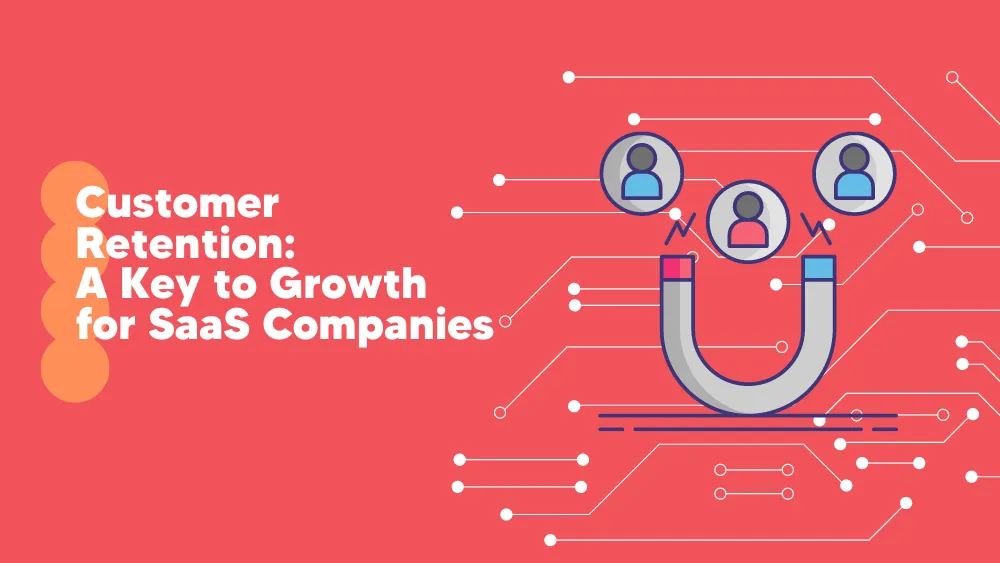As the industry of SaaS and software is evolving day by day, understanding the importance of Customer Lifetime Value (CLV) has become paramount for sustained success. CLV truly serves as a guiding light, illuminating the long-term value that customers bring to businesses. It goes beyond the traditional transactional mindset and reveals the potential for customer loyalty, retention, and profitability.
In this article, we will delve into the significance of CLV for SaaS and software companies, exploring its calculation, key components, and impact on customer segmentation and retention strategies. Join us on this journey as we uncover the immense value of customer lifetime value and how it can propel businesses toward remarkable growth and success.
What is Customer Lifetime Value (CLV)?
As we all know, customers are at the core of any business: without customers, there is no profit; without customers, no business can survive. Therefore, understanding the true value of a customer extends far beyond their initial purchase.
By understanding CLV, companies can make informed decisions about resource allocation, marketing strategies, and customer retention efforts.
Key Components of CLV
Customer Acquisition Cost (CAC)
CAC represents the cost of acquiring a new customer, including marketing, advertising, and sales expenses. It is important to factor in CAC when calculating CLV, as it helps determine the return on investment for acquiring each customer.
Average Revenue Per User (ARPU)
ARPU measures each customer’s average revenue during their relationship with the business. It takes into account subscription fees, additional purchases, and upgrades. Increasing ARPU contributes to higher CLV, making it essential to focus on upselling, cross-selling, and delivering value-added services.
Customer Retention Rate
Customer retention rate quantifies the percentage of customers who continue their subscriptions or engagement with the business over a specific period. It directly impacts CLV since higher retention rates result in longer customer relationships and increased revenue.
Relevance of CLV for SaaS and Software Companies
CLV holds particular relevance for SaaS and software companies due to their subscription-based business models. Unlike traditional businesses, these companies rely on recurring revenue from subscriptions, making customer retention a critical factor for long-term success.
CLV helps SaaS and software companies understand the lifetime revenue potential of each customer, guiding decisions related to pricing strategies, customer segmentation, and marketing investments. By identifying and targeting high-value customer segments, these companies can allocate resources more effectively and tailor their offerings to meet the specific needs of their most valuable customers.
Furthermore, CLV provides valuable insights into customer churn and retention rates. By focusing on reducing churn and improving customer satisfaction, SaaS and software companies can increase CLV by extending customer lifecycles and fostering loyalty.
Therefore, CLV is a vital metric for SaaS and software companies as it provides a holistic perspective on customer value, considering both revenue generation and long-term potential. By leveraging CLV, businesses can optimize their strategies, enhance customer experiences, and maximize profitability in the dynamic landscape of subscription-based models.
Why is CLV Important for SaaS and Software Companies?
SaaS (Software as a Service) and software companies encounter unique customer acquisition and retention challenges. CLV plays a crucial role in addressing these challenges and driving long-term success. Let’s explore why CLV is particularly important for SaaS and software companies:
Customer Acquisition and Retention Challenges
SaaS and software companies often face fierce competition, making customer acquisition complex and costly. Moreover, retaining customers can be challenging due to the ever-evolving nature of the industry, where new technologies and competitors constantly emerge. CLV helps these companies navigate these challenges by shifting the focus from short-term gains to the long-term value each customer brings.
Profitability Analysis
CLV provides SaaS and software companies with a comprehensive understanding of the profitability of acquiring and retaining customers. By comparing CLV with the cost of customer acquisition (CAC), businesses can assess the effectiveness of their marketing and sales efforts. If the CLV exceeds the CAC, it indicates a positive return on investment, highlighting the profitability of acquiring and retaining customers.
Influencing Business Decisions
CLV significantly impacts critical business decisions, including pricing strategies, customer segmentation, and marketing investments:
- Pricing Strategies
CLV insights enable SaaS and software companies to determine optimal pricing models. By understanding the long-term value of customers, businesses can align their pricing structures with customer expectations and the perceived value of their offerings. CLV analysis ensures that pricing decisions are profitable while retaining a competitive edge.
- Customer Segmentation
CLV helps in segmenting customers based on their value to the business. By identifying high-value customer segments, companies can personalize their marketing messages and tailor their products or services to meet the specific needs of these segments. This enhances customer satisfaction and improves customer retention, leading to higher CLV.
- Marketing Investments
CLV guides marketing investments by identifying the most valuable customers. Businesses can maximize their return on marketing investments by allocating resources to retain and engage high CLV customers. CLV analysis allows companies to optimize their marketing strategies and focus on customer acquisition channels that yield higher CLV.
CLV is crucial for SaaS and software companies as it helps overcome customer acquisition and retention challenges. It provides insights into the profitability of acquiring and retaining customers, enabling businesses to make informed decisions regarding pricing, customer segmentation, and marketing investments.
How to Calculate Customer Lifetime Value (CLV)?
Calculating Customer Lifetime Value (CLV) is essential for understanding the long-term value a customer brings to a business. Let’s break down the process into a step-by-step guide:
Define the Time Period: First, determine the time period for which you want to calculate CLV. It can be monthly, quarterly, or annually, depending on your business model and objectives.
Calculate Average Revenue per User (ARPU): To calculate ARPU, divide the total revenue generated by the number of active users within the defined time period. The formula for ARPU is:
Determine Customer Retention Rate: To calculate the customer retention rate, you need to know the number of active customers over the specified period.
The formula for the retention rate is as follows:
Calculate CLV: Once you have the ARPU and retention rate, you can calculate CLV using the following formula:
Customer Lifetime is the average duration a customer remains active with the business. It is the reciprocal of the churn rate (1 / Churn Rate). Churn rate is the percentage of customers lost during the defined time period.
For example, if the churn rate is 20% (0.2), the customer lifetime is 1 / 0.2 = 5.
Substituting the values into the formula, CLV = ARPU * (5 / 0.2) = 25 * ARPU.
The CLV will be 25 times the ARPU.
Example Calculation
Let’s assume a SaaS company has generated $100,000 in revenue over a year from 500 active users. The company had 400 customers at the start of the year and acquired 200 new customers then. The churn rate is calculated as ((400 – 200) / 400) x 100 = 50%.
ARPU = $100,000 / 500 = $200
Customer Lifetime = 1 / 0.5 (Churn Rate) = 2
CLV = $200 * (2 / 0.5) = $800
Based on this calculation, the CLV for each customer is $800.
By following this step-by-step guide, businesses can accurately calculate CLV, providing valuable insights into customer value and facilitating strategic decision-making related to customer acquisition, retention, and overall business growth. Though, Customer Lifetime Value (CLV) goes beyond just measuring the financial value of individual customers. It can also be a powerful competitive advantage for SaaS and software companies. By focusing on CLV, businesses can differentiate themselves from competitors and foster long-term customer loyalty.
Furthermore, the insights gained from CLV analysis can inform product development and innovation. Understanding the preferences, needs, and pain points of high CLV customers allows companies to tailor their products or services to meet those requirements better. This customer-centric approach enhances the overall customer experience, leading to increased CLV and a competitive edge in the market.
Strategies to Improve CLV for SaaS and Software Companies
To increase Customer Lifetime Value (CLV) and foster long-term customer relationships, SaaS and software companies can implement the following strategies:
-
Enhance Customer Onboarding and User Experience
Make the onboarding process seamless and user-friendly. Provide clear instructions, tutorials, and resources to help customers get started quickly and effectively. A positive onboarding experience sets the real foundation for long-term engagement and satisfaction.
-
Implement Customer Success Programs
Establish customer success programs to support customers throughout their journey proactively. Offer personalized assistance, training sessions, and regular check-ins to ensure customers are maximizing the value of your software. Helping customers achieve their goals increases satisfaction and retention—a win-win.
-
Upsell and Cross-Sell Relevant Products or Features
Identify opportunities to upsell or cross-sell additional products, modules, or features to existing customers. Understand their needs and provide targeted recommendations that align with their objectives. This approach not only increases CLV but also deepens customer engagement and loyalty.
-
Encourage Referrals and Word-of-Mouth Marketing
This is a must! Leverage the power of satisfied customers by implementing referral programs. Incentivize customers to refer new prospects, rewarding them with discounts, exclusive features, or other incentives. Positive word-of-mouth marketing can significantly impact CLV by attracting high-quality leads and enhancing brand reputation.
-
Continuously Analyze and Optimize Pricing Strategies
Review and analyze your pricing strategies to ensure they align with customer expectations and market conditions. Consider introducing tiered pricing plans or offering flexible subscription options that cater to various customer segments. Test different pricing models and monitor their impact on CLV to optimize revenue generation.
-
Provide Excellent Customer Support
Deliver exceptional customer support to address any issues or concerns promptly. Invest in a responsive support team that can efficiently handle inquiries and provide technical assistance. Timely and effective support fosters customer satisfaction, increases retention, and enhances CLV. Remember, relations matter!
Conclusion
This article explored the significance of Customer Lifetime Value (CLV) for SaaS and software companies. We discussed how CLV measures customers’ long-term value and examined its key components, including customer acquisition cost, average revenue per user, and customer retention rate. We also highlighted these companies’ unique challenges in acquiring and retaining customers and how CLV helps overcome these obstacles.
Furthermore, we provided a step-by-step guide on calculating CLV and shared strategies to improve it, such as enhancing user experience, implementing customer success programs, upselling and cross-selling, encouraging referrals, and optimizing pricing strategies.
So, we are now perfectly aware that Customer Lifetime Value (CLV) is a key metric for SaaS and software companies seeking sustained growth and profitability.
In summary, embracing CLV as a central focus allows SaaS and software companies to shift towards customer-centric strategies, driving customer satisfaction, retention, and long-term growth. By understanding the true value of each customer and implementing the strategies outlined in this article, businesses can unlock the untapped potential within their customer base, paving the way for sustainable success in today’s competitive landscape.






